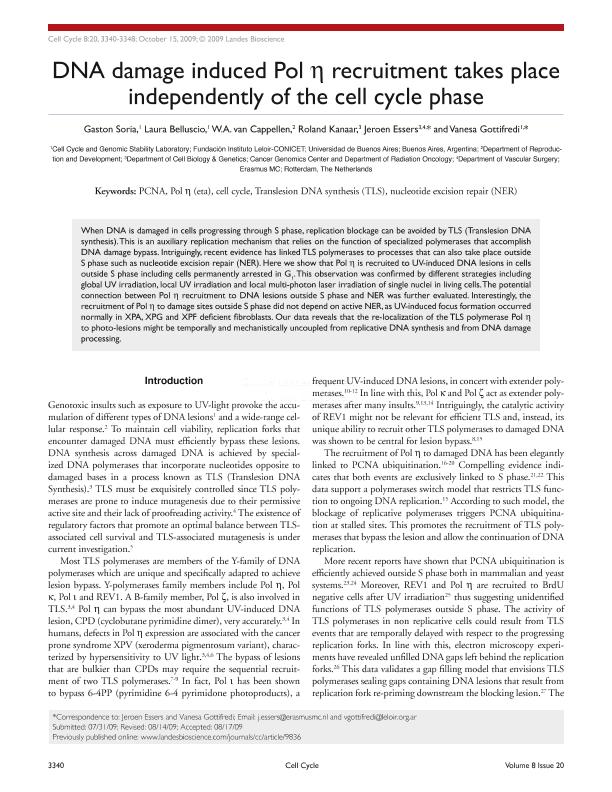Artículo
DNA damage induced Pol eta recruitment takes place independently of the cell cycle phase
Soria, Ramiro Gasto; Belluscio, Laura María ; van Cappellen, W. A.; Kanaar, Roland; Essers, Jeroen; Gottifredi, Vanesa
; van Cappellen, W. A.; Kanaar, Roland; Essers, Jeroen; Gottifredi, Vanesa
 ; van Cappellen, W. A.; Kanaar, Roland; Essers, Jeroen; Gottifredi, Vanesa
; van Cappellen, W. A.; Kanaar, Roland; Essers, Jeroen; Gottifredi, Vanesa
Fecha de publicación:
10/2009
Editorial:
Landes Bioscience
Revista:
Cell Cycle
ISSN:
1538-4101
e-ISSN:
1551-4005
Idioma:
Inglés
Tipo de recurso:
Artículo publicado
Clasificación temática:
Resumen
When DNA is damaged in cells progressing through S phase, replication blockage can be avoided by TLS (Translesion DNA synthesis). This is an auxiliary replication mechanism that relies on the function of specialized polymerases that accomplish DNA damage bypass. Intriguingly, recent evidence has linked TLS polymerases to processes that can also take place outside S phase such as nucleotide excision repair (NER). Here we show that Pol eta is recruited to UV-induced DNA lesions in cells outside S phase including cells permanently arrested in G(1). This observation was confirmed by different strategies including global UV irradiation, local UV irradiation and local multi-photon laser irradiation of single nuclei in living cells. The potential connection between Pol eta recruitment to DNA lesions outside S phase and NER was further evaluated. Interestingly, the recruitment of Pol eta to damage sites outside S phase did not depend on active NER, as UV-induced focus formation occurred normally in XPA, XPG and XPF deficient fibroblasts. Our data reveals that the re-localization of the TLS polymerase Pol eta to photo-lesions might be temporally and mechanistically uncoupled from replicative DNA synthesis and from DNA damage processing.
Archivos asociados
Licencia
Identificadores
Colecciones
Articulos(IIBBA)
Articulos de INST.DE INVEST.BIOQUIMICAS DE BS.AS(I)
Articulos de INST.DE INVEST.BIOQUIMICAS DE BS.AS(I)
Articulos(OCA CIUDAD UNIVERSITARIA)
Articulos de OFICINA DE COORDINACION ADMINISTRATIVA CIUDAD UNIVERSITARIA
Articulos de OFICINA DE COORDINACION ADMINISTRATIVA CIUDAD UNIVERSITARIA
Citación
Soria, Ramiro Gasto; Belluscio, Laura María; van Cappellen, W. A.; Kanaar, Roland; Essers, Jeroen; et al.; DNA damage induced Pol eta recruitment takes place independently of the cell cycle phase; Landes Bioscience; Cell Cycle; 8; 20; 10-2009; 3340-3348
Compartir
Altmétricas



